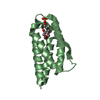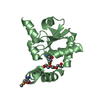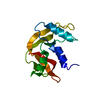+ Open data
Open data
- Basic information
Basic information
| Entry | Database: PDB / ID: 1otr | ||||||
|---|---|---|---|---|---|---|---|
| Title | Solution Structure of a CUE-Ubiquitin Complex | ||||||
 Components Components |
| ||||||
 Keywords Keywords |  CELL CYCLE / PROTEIN-PROTEIN COMPLEX CELL CYCLE / PROTEIN-PROTEIN COMPLEX | ||||||
| Function / homology |  Function and homology information Function and homology information: / : / : / Metalloprotease DUBs / : / : / Synthesis of active ubiquitin: roles of E1 and E2 enzymes / Regulation of PTEN localization / ER Quality Control Compartment (ERQC) / Interleukin-1 signaling ...: / : / : / Metalloprotease DUBs / : / : / Synthesis of active ubiquitin: roles of E1 and E2 enzymes / Regulation of PTEN localization / ER Quality Control Compartment (ERQC) / Interleukin-1 signaling / Negative regulators of DDX58/IFIH1 signaling / E3 ubiquitin ligases ubiquitinate target proteins / Translesion Synthesis by POLH / Translesion synthesis by POLK / Translesion synthesis by POLI / : / UCH proteinases / Regulation of PTEN stability and activity / Aggrephagy / Regulation of TP53 Degradation / Translesion synthesis by REV1 / CDK-mediated phosphorylation and removal of Cdc6 / nuclear-transcribed mRNA catabolic process, no-go decay / FBXL7 down-regulates AURKA during mitotic entry and in early mitosis / Endosomal Sorting Complex Required For Transport (ESCRT) / Ubiquitin Mediated Degradation of Phosphorylated Cdc25A /  Peroxisomal protein import / Orc1 removal from chromatin / ABC-family proteins mediated transport / Recruitment and ATM-mediated phosphorylation of repair and signaling proteins at DNA double strand breaks / MAPK6/MAPK4 signaling / Antigen processing: Ubiquitination & Proteasome degradation / Formation of the ternary complex, and subsequently, the 43S complex / Ribosomal scanning and start codon recognition / Formation of TC-NER Pre-Incision Complex / Ub-specific processing proteases / Dual incision in TC-NER / Major pathway of rRNA processing in the nucleolus and cytosol / SRP-dependent cotranslational protein targeting to membrane / GTP hydrolysis and joining of the 60S ribosomal subunit / Formation of a pool of free 40S subunits / Gap-filling DNA repair synthesis and ligation in TC-NER / Nonsense Mediated Decay (NMD) independent of the Exon Junction Complex (EJC) / Nonsense Mediated Decay (NMD) enhanced by the Exon Junction Complex (EJC) / L13a-mediated translational silencing of Ceruloplasmin expression / Peroxisomal protein import / Orc1 removal from chromatin / ABC-family proteins mediated transport / Recruitment and ATM-mediated phosphorylation of repair and signaling proteins at DNA double strand breaks / MAPK6/MAPK4 signaling / Antigen processing: Ubiquitination & Proteasome degradation / Formation of the ternary complex, and subsequently, the 43S complex / Ribosomal scanning and start codon recognition / Formation of TC-NER Pre-Incision Complex / Ub-specific processing proteases / Dual incision in TC-NER / Major pathway of rRNA processing in the nucleolus and cytosol / SRP-dependent cotranslational protein targeting to membrane / GTP hydrolysis and joining of the 60S ribosomal subunit / Formation of a pool of free 40S subunits / Gap-filling DNA repair synthesis and ligation in TC-NER / Nonsense Mediated Decay (NMD) independent of the Exon Junction Complex (EJC) / Nonsense Mediated Decay (NMD) enhanced by the Exon Junction Complex (EJC) / L13a-mediated translational silencing of Ceruloplasmin expression /  ribosomal large subunit export from nucleus / ribosomal large subunit export from nucleus /  ubiquitin binding / modification-dependent protein catabolic process / ubiquitin binding / modification-dependent protein catabolic process /  ribosomal large subunit assembly / ribosomal large subunit assembly /  protein tag activity / protein tag activity /  ribosome biogenesis / cytoplasmic translation / cytosolic large ribosomal subunit / ribosome biogenesis / cytoplasmic translation / cytosolic large ribosomal subunit /  endonuclease activity / protein ubiquitination / structural constituent of ribosome / endonuclease activity / protein ubiquitination / structural constituent of ribosome /  ubiquitin protein ligase binding / ubiquitin protein ligase binding /  nucleus / nucleus /  cytosol / cytosol /  cytoplasm cytoplasmSimilarity search - Function | ||||||
| Biological species |   Saccharomyces cerevisiae (brewer's yeast) Saccharomyces cerevisiae (brewer's yeast) | ||||||
| Method |  SOLUTION NMR / torsion angle dynamics, SOLUTION NMR / torsion angle dynamics,  simulated annealing simulated annealing | ||||||
 Authors Authors | Kang, R.S. / Daniels, C.M. / Salerno, W.J. / Radhakrishnan, I. | ||||||
 Citation Citation |  Journal: Cell(Cambridge,Mass.) / Year: 2003 Journal: Cell(Cambridge,Mass.) / Year: 2003Title: Solution Structure of a CUE-Ubiquitin Complex Reveals a Conserved Mode of Ubiquitin Binding Authors: Kang, R.S. / Daniels, C.M. / Francis, S.A. / Shih, S.C. / Salerno, W.J. / Hicke, L. / Radhakrishnan, I. | ||||||
| History |
|
- Structure visualization
Structure visualization
| Structure viewer | Molecule:  Molmil Molmil Jmol/JSmol Jmol/JSmol |
|---|
- Downloads & links
Downloads & links
- Download
Download
| PDBx/mmCIF format |  1otr.cif.gz 1otr.cif.gz | 770.7 KB | Display |  PDBx/mmCIF format PDBx/mmCIF format |
|---|---|---|---|---|
| PDB format |  pdb1otr.ent.gz pdb1otr.ent.gz | 671.2 KB | Display |  PDB format PDB format |
| PDBx/mmJSON format |  1otr.json.gz 1otr.json.gz | Tree view |  PDBx/mmJSON format PDBx/mmJSON format | |
| Others |  Other downloads Other downloads |
-Validation report
| Arichive directory |  https://data.pdbj.org/pub/pdb/validation_reports/ot/1otr https://data.pdbj.org/pub/pdb/validation_reports/ot/1otr ftp://data.pdbj.org/pub/pdb/validation_reports/ot/1otr ftp://data.pdbj.org/pub/pdb/validation_reports/ot/1otr | HTTPS FTP |
|---|
-Related structure data
| Similar structure data |
|---|
- Links
Links
- Assembly
Assembly
| Deposited unit | 
| |||||||||
|---|---|---|---|---|---|---|---|---|---|---|
| 1 |
| |||||||||
| NMR ensembles |
|
- Components
Components
| #1: Protein/peptide | Mass: 5573.291 Da / Num. of mol.: 1 / Fragment: Amino-terminal CUE Domain, Residues 6-54 Source method: isolated from a genetically manipulated source Source: (gene. exp.)   Saccharomyces cerevisiae (brewer's yeast) Saccharomyces cerevisiae (brewer's yeast)Gene: CUE2 / Plasmid: pMCSG / Species (production host): Escherichia coli / Production host:   Escherichia coli BL21(DE3) (bacteria) / Strain (production host): BL21(DE3) / References: UniProt: P36075 Escherichia coli BL21(DE3) (bacteria) / Strain (production host): BL21(DE3) / References: UniProt: P36075 |
|---|---|
| #2: Protein |  Mass: 8568.769 Da / Num. of mol.: 1 Source method: isolated from a genetically manipulated source Source: (gene. exp.)   Saccharomyces cerevisiae (brewer's yeast) Saccharomyces cerevisiae (brewer's yeast)Gene: UBI1 / Plasmid: pET-3a / Species (production host): Escherichia coli / Production host:   Escherichia coli BL21(DE3) (bacteria) / Strain (production host): BL21(DE3) / References: UniProt: P61864, UniProt: P0CG63*PLUS Escherichia coli BL21(DE3) (bacteria) / Strain (production host): BL21(DE3) / References: UniProt: P61864, UniProt: P0CG63*PLUS |
-Experimental details
-Experiment
| Experiment | Method:  SOLUTION NMR SOLUTION NMR | ||||||||||||||||||||
|---|---|---|---|---|---|---|---|---|---|---|---|---|---|---|---|---|---|---|---|---|---|
| NMR experiment |
|
- Sample preparation
Sample preparation
| Details |
| |||||||||||||||
|---|---|---|---|---|---|---|---|---|---|---|---|---|---|---|---|---|
| Sample conditions | Ionic strength: 20 mM sodium phosphate, pH 7.0, 0.2% NaN3 / pH: 7.0 / Pressure: 1 atm / Temperature: 298 K | |||||||||||||||
Crystal grow | *PLUS Method: other / Details: NMR |
-NMR measurement
| NMR spectrometer | Type: Varian INOVA / Manufacturer: Varian / Model : INOVA / Field strength: 600 MHz : INOVA / Field strength: 600 MHz |
|---|
- Processing
Processing
| NMR software |
| ||||||||||||||||||||||||||||||||
|---|---|---|---|---|---|---|---|---|---|---|---|---|---|---|---|---|---|---|---|---|---|---|---|---|---|---|---|---|---|---|---|---|---|
| Refinement | Method: torsion angle dynamics,  simulated annealing / Software ordinal: 1 simulated annealing / Software ordinal: 1 Details: The structures are based on a total of 3328 distance restraints, including 3238 NOE-derived distance restraints [2560 unambiguous and 678 ambiguous restraints], 90 hydrogen bonding distance ...Details: The structures are based on a total of 3328 distance restraints, including 3238 NOE-derived distance restraints [2560 unambiguous and 678 ambiguous restraints], 90 hydrogen bonding distance restraints, and 150 torsion angle restraints. | ||||||||||||||||||||||||||||||||
| NMR representative | Selection criteria: closest to the average | ||||||||||||||||||||||||||||||||
| NMR ensemble | Conformer selection criteria: The submitted conformer models are the 20 structures with the lowest restraint energies, restraint violations, and RMS deviations from ideal covalent geometry Conformers calculated total number: 80 / Conformers submitted total number: 20 |
 Movie
Movie Controller
Controller













 PDBj
PDBj











